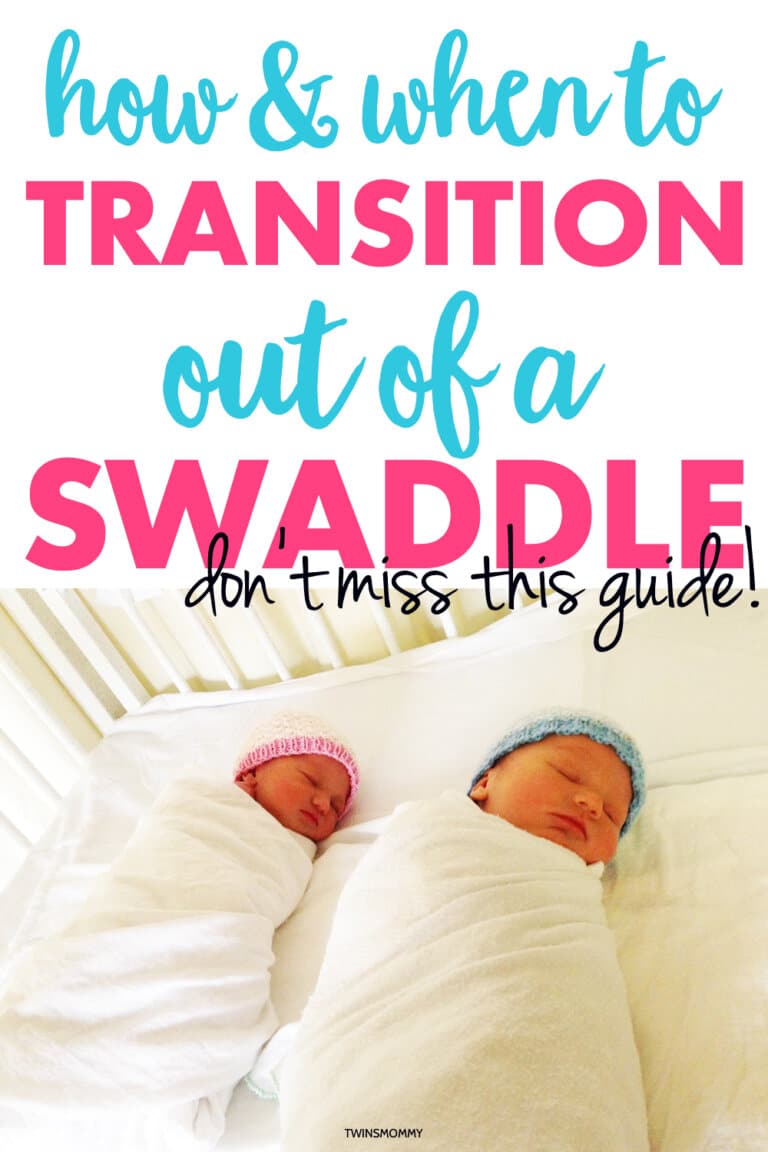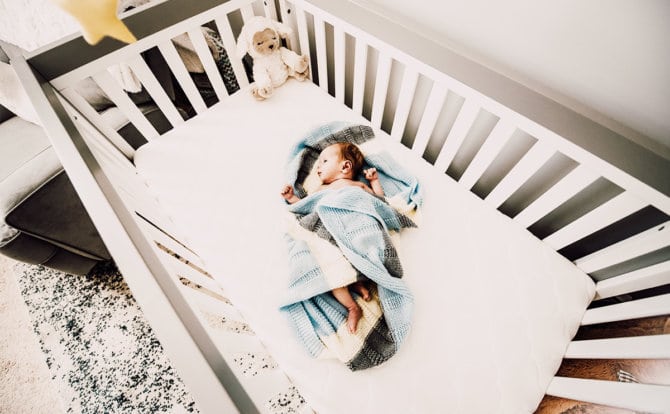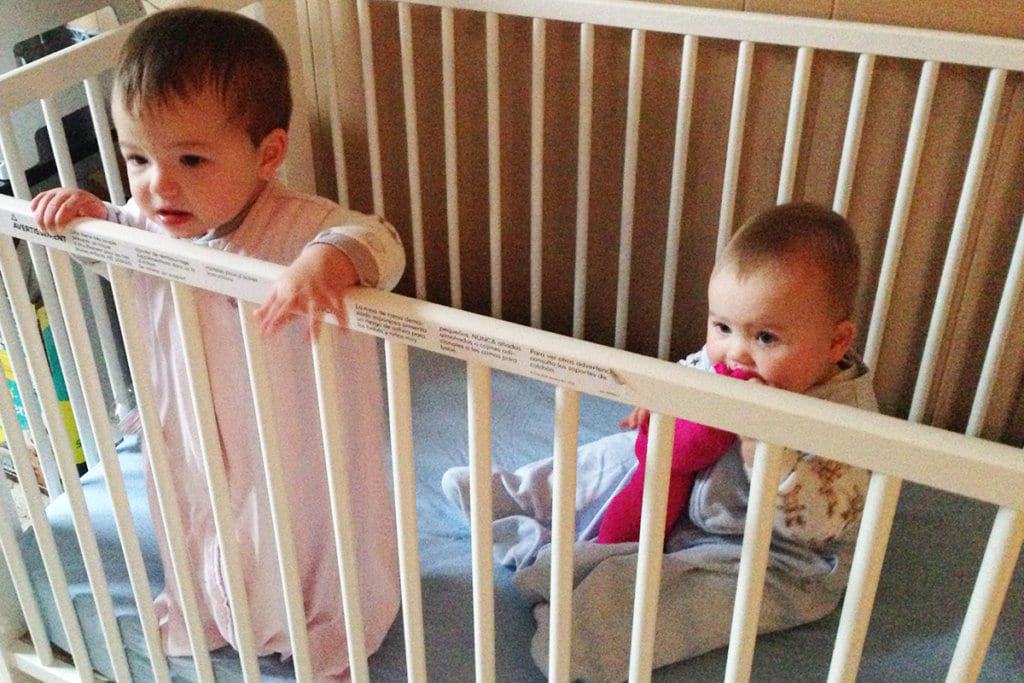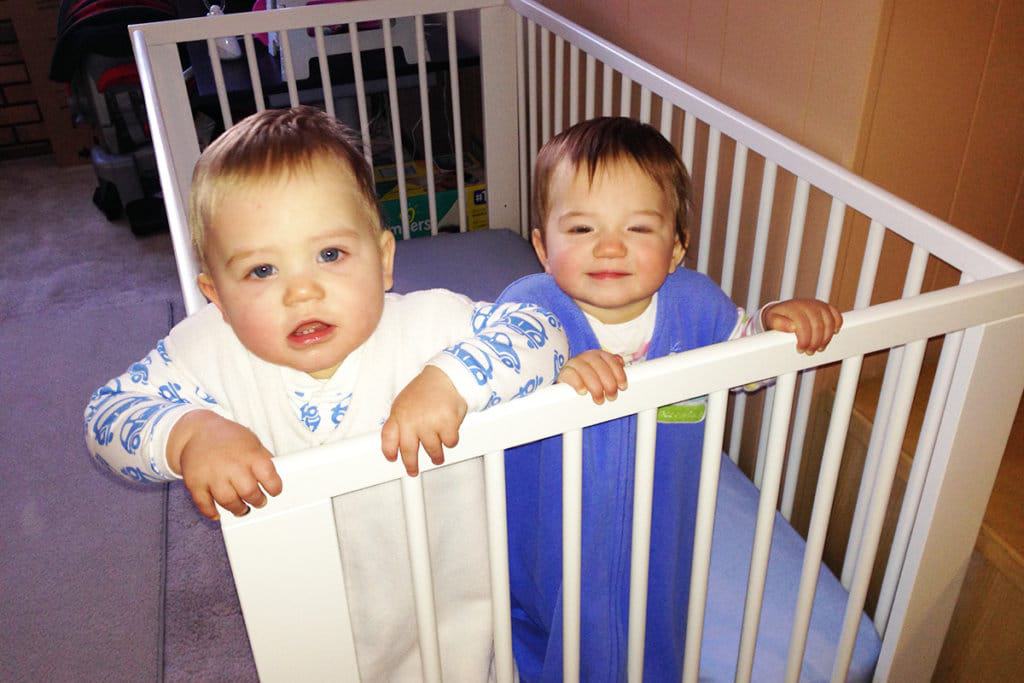Learn when it’s time to transition out of a swaddle for your baby

Time to bundle up your baby burrito in a comfy swaddle and hopefully get some much needed sleep.
But there are so many questions that come along with swaddling your little one.
Is it safe?
How exactly do you make a swaddle?
What are the benefits of swaddling?
What the heck is the difference between a swaddle and a sleep sack and which is the best?
So grab your little bundle of joy and get ready to bundle them up.
What Is A Swaddle?
In its simplest terms, a swaddle means to wrap in a cloth. The swaddling of infants is a centuries old practice to restrict the movement of their limbs.
But why would you want to restrict their movement?
What Is The Purpose Of A Swaddle?
Your newborn is used to being tightly nestled in your womb. When they arrive into this world and are no longer floating snugly in amniotic fluid, they can be easily startled. Swaddling your newborn helps to prevent their natural startle reflex. Swaddling can also help to ease a fussy baby by feeling like you are holding or hugging them and help them to self-soothe. Plus they look so darn cute all bundled up like a baby burrito.
The Benefits Of Swaddling

If the purpose of swaddling is to help calm baby and prevent their startle reflex, what are the benefits? Other than learning to self soothe, swaddling can help them to sleep longer.
When babies are correctly swaddled, it is a great way for them to feel safe and keep them comfortable and calm.
Is Swaddling Safe?
Absolutely! Parents have been swaddling their little ones for centuries! There are a few key things to remember when you are swaddling your little bundle of joy.
Make sure they are swaddled snuggly but not too night. You still want to allow your baby enough room to breathe where you can place a few fingers between the swaddling blanket and your baby’s chest. It should also be loose enough at the bottom to allow baby some movement with their legs.
Always, ALWAYS, put baby to sleep on his or her back when swaddled, or not swaddled for that matter.
Remember, back is best!
Make sure baby doesn’t overheat. When swaddled up, this could increase the risk of baby overheating which could put them at a higher risk for SIDS. Wherever they are sleeping, ensure that it stays somewhere between 68-72F to prevent baby from getting too warm.
The only thing they really need under a swaddle is a onesie or light pajama.
Swaddle for sleep. Whether going to bed at night or taking a nap, it is perfectly safe to swaddle baby as long as you are following these guidelines. Try to avoid swaddling baby if you are not trying to get them to go to sleep.
Swaddling them should signal that it is time for sleep and will help to establish a routine.
Step By Step How To Swaddle
It can take a bit of trial and error to get your swaddling technique down. While the process itself is pretty simple, it can take some practice and the right type of blanket. The most common types of swaddle blankets are muslin or 100% cotton and have a bit of stretch to them.
When I was in the hospital, the nurse showed me how to swaddle my newborn twins.

They are soft and breathable and allow you to wrap your baby securely without ensuring that they won’t get too warm.
First, find a safe, flat surface. This could be a bed or on the floor. Spread out the swaddling blanket in a diamond shape.
Take the top corner and fold it down about six inches, this is where baby’s head will go.
Next, place baby face-up on the blanket. Their head should be placed on top of the folded part with their body pointing down to the corner at the bottom.
When you start to fold the blanket over baby, it should go from side, bottom, side.
Generally starting with the left arm and side, gently hold baby’s left arm down and fold the blanket, snuggly, all the way over. Next bring the blanket up from the bottom over the side that you have already folded.
Be sure that no part of the blanket is covering baby’s face or too tight on their neck.
Finally, gently hold down baby’s right arm and bring the remainder of the blanket over the already folded pieces tucking the remainder of the blanket behind baby.
Make sure that the swaddle is snug but not too tight.
How To Transition Swaddles
While you might want to swaddle your little one until they can walk, the general age to transition swaddles is around three to five months.
The main reason to stop swaddling your baby and to make the transition to a sleep sack is for their safety. When they can flip themselves over and lay on their tummy by themselves, that is when you need to make the switch.
Even if they can’t flip over in their swaddle yet, you don’t want to take that chance.
While there are many different ways to transition out of a swaddle, many moms find it beneficial to switch cold turkey to a sleep sack. There are many options to make baby feel snug and cozy when using a sleep sack.
However, just be sure to not introduce a blanket too soon, just because they are transitioning out of the swaddle does not mean that they need a blanket to stay warm.
When I transitioned our twins, we used the Halo sleep sacks.
These are great for many different reasons. You can get them with or without arm wraps, in cotton or microfleece, and in various sizes.
There are many different types of sleep sacks that can help to calm baby and give them (and you) a good night’s rest.


And what’s best with the halo sacks is that they grow with them.
If you are interested in seeing other types of sleep sacks, here are my other top reccomendations.
Baby Sleep Sacks
Sleepea Second Swaddle
If you aren’t a fan of trying to swaddle with a blanket or your baby always seems to wiggle themselves loose, then the Sleepea Second Swaddle is a great backup. There are no straps to worry about, just a simple, soft and breathable zippered sack to keep baby cozy and snug.
Swaddle Strap
If you like the idea of using a blanket to swaddle but just can’t seem to get the wrap snug enough, try the swaddle strap. It includes inner straps to prevent the swaddle from moving upward, stays positioned above the hips for healthy hip development, and has soft little arm pillows for security and comfort.
Available in two different sizes and perfect for babies that also might like to keep their feet free.
Love to Dream Swaddle
While swaddling traditionally puts baby’s arms at their sides, this swaddle sleep sack allows baby to keep arms up in their natural position.
The bottom portion of the sleep sack is wider allowing for baby’s natural leg flexion and some wiggle room. The fabric itself is very stretchy yet snug enough for baby to still feel like they are being hugged.
Zen Sack
The Zen Sack is different from many of the other sleep sacks out there. It is a lightly weighted sleep sack that doesn’t restrict baby’s movement. The weight is contained within an egg shape on one side of the sack.
It has adjustable arm straps to accommodate growing babies and a two way zipper for easy middle of the night diaper changes. Using the Zen Sack is a great way to transition out of a swaddle as it still allows baby to feel as if they are being snuggled with the gentle weight placed on them.
Once baby gets older and rolls onto their tummy more, the sack can easily be switched around so the weighted part is on the back, giving them the feeling that you are still right there with them.
This company actually makes a whole line of lightly weighted sleepwear for babies, from newborn to 15+ months.
Long Sleeve Sleep Sack
For those cooler nights, make sure that baby is all wrapped up in a cozy, fleece sleep sack. Ideal for babies 0-9 months, these fleece sleep sacks will ensure that baby stays warm and comfortable, allowing them to sleep longer.
What Is The Difference Between Sleep Sack & Swaddles?
The word “swaddle” can often be used interchangeably with the use of a sleep sack.
Many parents use the word swaddle in reference to the act of swaddling their child rather than the actual material they are using. A swaddle is generally a thin, large blanket used to wrap up your baby burrito.
A sleep sack, on the other hand, is more of a wearable blanket that can be used to restrict the baby’s arms but also allowing their arms out.
Sleep sacks are generally recommended for babies under one year of age that are still at risk of SIDS rather than using a blanket.
Sleep sacks can still provide that comfort of being snuggled up while still providing older babies room to move around without the risk of not being able to breathe if they flip themselves over.
So whether you choose to swaddle from the very beginning or use a sleep sack, there are many great options available.
If you need help on where the best place to have for your baby to sleep, check out my post on the smart bassinet.
I hope you enjoyed this post and let me know in the comments if you use a sleep sack to transition out of a swaddle.




Leave a Reply